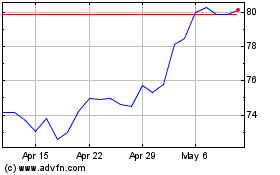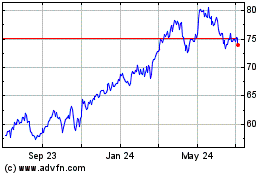After Earnings Miss, AIG Scales Back Profit Goals
February 15 2017 - 6:48PM
Dow Jones News
By Leslie Scism
American International Group Inc.'s turnaround plan took a hit
following a disappointing fourth-quarter earnings report that sent
its shares tumbling 9%.
The insurance giant told analysts that it will now be more
difficult to meet two important year-end targets for improving
profitability in the company's core unit of selling
property-casualty policies to businesses. It also surprised Wall
Street with a $5.6 billion addition to reserves that was larger
than anticipated.
"There is a question, to what degree has this turnaround
stalled? To what degree is the progress sliding backward?" said
Cathy Seifert, an equity analyst with CFRA Research. "It speaks to
credibility. There was an agenda set out a year ago, and they
haven't hit all the targets."
AIG's 9% drop Wednesday to $60.85 was the biggest percentage
decline for the stock since August 2011. It was also the worst
performer in the S&P 500 on the day.
AIG nearly collapsed during the 2008 global financial crisis and
needed a $185 billion bailout to keep going. Now, Chief Executive
Peter Hancock is trying to sell businesses, reduce expenses and
make big changes in the insurance products it sells in a bid to
boost profitability. It is trying to satisfy activist shareholders
Carl Icahn and John Paulson, who have publicly called for AIG to
break into smaller pieces.
AIG added Mr. Paulson and a representative of Mr. Icahn to its
board last spring. Mr. Paulson's hedge-fund firm, Paulson & Co,
disclosed Tuesday that its holdings of AIG dropped to 4.8 million
shares as of Dec. 31, compared with roughly 9 million on Sept.
30.
A key part of Mr. Hancock's turnaround plan is a set of
profitability targets announced in January 2016 designed to bring
AIG's results in line with the best of its rivals. Among those
goals was an underlying 10% return on equity on its core business
by the end of this year.
But on Wednesday it reduced that target to 9.5%. Return on
equity reflects profits earned against capital invested in the
business.
AIG also said it would take until 2018 to meet another closely
watched goal: a reduction in the "loss ratio" on business-insurance
policies to levels achieved by its most-profitable peers. A loss
ratio is the amount of each premium dollar paid on claims and
related expenses.
AIG's goal was about 60 cents per dollar at year-end, but it
said it now is targeting 62 cents. That contrasts with the 65 cents
that AIG was paying two years ago.
Mr. Hancock reiterated a pledge started last year to return $25
billion to shareholders by the end of 2017 through buybacks and
dividends. AIG was more than halfway to that goal through Tuesday.
But the company emphasized in the earnings and a subsequent
conference call that reaching $25 billion is still subject to
regulatory approvals, discussions with ratings firms and "future
profit improvements."
Analysts spent part of the Wednesday call pressing AIG
executives for details about its $5.6 billion reserve boost, which
was far higher than expected. It follows a $3.6 billion addition in
the year-ago quarter.
Mr. Hancock and other executives cited "emerging trends" and new
claims data. They specifically cited worsening trends in vehicle
wrecks that affect policyholders' fleets of commercial vehicles,
more-expensive medical-malpractice claims and
financial-crisis-related liability claims that are costing more
than expected.
AIG said that much of the latest reserve addition would be
covered under a reinsurance agreement with Warren Buffett's
Berkshire Hathaway Inc. that was announced last month. The
agreement would reduce AIG's exposure to such charges going
forward, Mr. Hancock said.
Write to Leslie Scism at leslie.scism@wsj.com
(END) Dow Jones Newswires
February 15, 2017 18:33 ET (23:33 GMT)
Copyright (c) 2017 Dow Jones & Company, Inc.
American (NYSE:AIG)
Historical Stock Chart
From Mar 2024 to Apr 2024

American (NYSE:AIG)
Historical Stock Chart
From Apr 2023 to Apr 2024
